The True Dharma Eye  Zen Master Dgens THREE HUNDRED KANS WITH COMMENTARY AND VERSE BY John Daido Loori TRANSLATED BY Kazuaki Tanahashi and John Daido Loori
Zen Master Dgens THREE HUNDRED KANS WITH COMMENTARY AND VERSE BY John Daido Loori TRANSLATED BY Kazuaki Tanahashi and John Daido Loori  Shambhala BOSTON & LONDON 2011 Shambhala Publications, Inc. Horticultural Hall 300 Massachusetts Avenue Boston, Massachusetts 02115 www.shambhala.com 2005 by John Daido Loori Cover art: Side View Daruma by Hakuin Ekaku (16851769). Used with permission of the Gitter-Yelen Collection. Cover design: Diana Coe/ko Design Studio All rights reserved. No part of this book may be reproduced in any form or by any means, electronic or mechanical, including photocopying, recording, or by any information storage and retrieval system, without permission in writing from the publisher. [Shb genz sanbyakusoku. [Shb genz sanbyakusoku.
Shambhala BOSTON & LONDON 2011 Shambhala Publications, Inc. Horticultural Hall 300 Massachusetts Avenue Boston, Massachusetts 02115 www.shambhala.com 2005 by John Daido Loori Cover art: Side View Daruma by Hakuin Ekaku (16851769). Used with permission of the Gitter-Yelen Collection. Cover design: Diana Coe/ko Design Studio All rights reserved. No part of this book may be reproduced in any form or by any means, electronic or mechanical, including photocopying, recording, or by any information storage and retrieval system, without permission in writing from the publisher. [Shb genz sanbyakusoku. [Shb genz sanbyakusoku.
English] The true dharma eye: Zen Master Dogens three hundred koans / with commentary and verse by John Daido Loori; translated by Kazuaki Tanahashi and John Daido Loori. p. cm. eISBN 978-0-8348-2311-2 ISBN 978-1-59030-465-5 (hardcover: alk. paper) ISBN 978-1-59030-465-5 (paperback) 1. I. I.
Loori, John Daido. II. Tanahashi, Kazuaki, 1933 III. Title. BQ9449.D654.S5331715 2005 294.385dc22 2005007961 Dedicated with deep gratitude to our dharma ancestors, and with deep confidence to the new Western generations Contents I would first like to acknowledge the contribution of Kazuaki Tanahashi. Translating with him the main cases collected by Dgen was a pleasure.
Kaz brought to the table not only his skills in the Chinese and Japanese languages but also a deep sense of appreciation for the spirit of Dgen. I am deeply indebted to Vanessa Zuisei Goddard for her editing skills and continual assistance in bringing this book to fruition as well as for the research that produced the glossaries and cross-reference appendix. I am grateful to Andy Ferguson for creating a lineage chart specifically for this book; I am sure it will help readers to better understand the historical context that frames many of these cases. I also owe a debt of gratitude to my successors, Bonnie Myotai Treace and Geoffrey Shugen Arnold, as well as dharma holder Konrad Ryushin Marchaj, for their meticulous proofreading of the manuscript; and to Ben Gleason and the Shambhala staff for their copyediting skills. My deep appreciation goes to the countless unnamed Zen students who were present at Zen Mountain Monastery for the talks I gave on these kans during the fifteen years that it took to develop this book. Finally, nine bows to my teacher Kun Taizan Maezumi, who encouraged me to create an American Shbgenz and was always supportive of my work with Dgens three hundred kans.
Although The True Dharma Eye is not yet an American Shbgenz , I hope that it will provide the first feeble steps in that direction. John Daido Loori Roshi The main cases for the three hundred kans in this book were selected by Eihei Dgen (12001253) from extensive volumes of Chinese Zen literature. As one of the first monastics transmitting the Zen teaching from China, Dgen returned to Japan in 1228. During the earliest years of his teaching, he compiled this selection and called it Shbgenz (Treasury of the True Dharma Eye). This Chinese-language Shbgenz served Dgen as a lifetime notebook for writing his dharma essays. For another book of his with the same title, he used more than seventy stories from this selection.
He would introduce a kan story in Chinese and comment on it in a brilliantly poetic and philosophical style in the Japanese language, which was written in a combination of the Chinese characters called kanji and the Japanese phonetics called kana. He repeated this pattern in a number of his essays. Of the two books by Dgen titled Shbgenz , the Chinese-language version ( Shinji , or Mana , version), presented here, is less known than the Japanese-language version ( Kana , or Keji , version). One of the standard versions of the Kana Shbgenz consists of ninety-five fascicles. (A fascicle is a chapter-long text bound separately as a book.) In 1767, Dgens original kan collection with commentary by Shigetsu Ein was published by his disciple Honk Katsud after Eins death. The text included Katsuds preface, and was titled Nempy Sambyakusoku Funogo .
There was no other copy of the text available for study until the last century. But a hand-copied manuscript, dated 1287, containing seventy-nine cases, which had been kept in the Kanazawa Archive in Yokohama, Kanagawa Prefecture, was published by Tokuj Oya in 1934. Our translation is based on the annotated text in Dgen Zenji Zensh (Complete Work of Zen Master Dgen), edited by Tokugen Sakai et al., Tokyo Shunjsha, 19881993. John Daido Loori Roshi has added his verses and commentaries to all three hundred cases of the Shinji Shbgenz . I have had the pleasure of translating the main cases from Chinese into English with him. We worked together intensely at our occasional meetings at Zen Mountain Monastery from 1995 to 2002.
The addition of commentaries by a later Zen master to a collection of kans is not unprecedented. For example, the Blue Cliff Record , one of the most revered Zen texts, was initiated by Xuedou Zhongxian (9801052), who selected one hundred kans and wrote capping verses to each case. Yuanwu Keqin (10631135) added pointers and commentaries after Xuedous death. Loori Roshis addition of new commentaries, more than seven and a half centuries after the selection of these three hundred kans, is extraordinary. In addition, the creation of a formal Zen text by a Western Zen teacher is unique. Loori Roshi has presented a number of these cases with commentaries in his weekly dharma discourses at Zen Mountain Monastery.
I am honored to be part of the team creating the book that embodies the authenticity of Dgen and the elucidation of the Zen teaching, made accessible to contemporary Western Zen practitioners. Kazuaki Tanahashi Berkeley, California Dgen Kans Japanese master Eihei Dgen was one of the most remarkable religious figures and teachers in the history of Zen. Although relatively unknown during his lifetime, he is now widely regarded as an outstanding philosopher, mystic, and poet. His works are having a tremendous impact, not only in Japan and within the St school of Zen Buddhism, but even more so in the West, where hes been discovered and studied extensively by philosophers, scholars, artists, and Buddhist practitioners. He is best known for his comprehensive and profound masterwork, the Kana , or Japanese, Shbgenz . This monumental achievement, a collection of ninety-five discourses and essays composed in Japanese between the years 1231 and 1253, is a unique expression of the Buddhadharma based on Dgens profound religious experience.
A less-known work of Dgens is his Mana Shbgenz , or Shbgenz Sambyakusoku (Treasury of the True Dharma Eye: Three Hundred Cases), a collection of three hundred case kans written in Chinese. This seminal work, which was to influence all of Dgens other teachings, remained in obscurity for many centuries. It wasnt until 1934 that it was rediscovered and made available to the general public by Professor Tokuj Oya, and only recently was its authenticity verified. Mana Shbgenz is a volume of three hundred kans that Dgen culled from Zen texts of the Song era during his travels in China between 1223 and 1227. And, unlike the classic collections of the period, these cases are not accompanied by either a title or a commentary. These traditional collections were the Blue Cliff Record ( Hekiganroku ) and the Book of Serenity ( Shyroku ).
The Blue Cliff Record was a collection of one hundred kans gathered by Master Xuedou, who appended his own verses and remarks as an aid to his students. Sixty years after Xuedous death, Master Yuanwu Keqin gave a series of talks on this collection and added his own commentaries to each case. The Blue Cliff Record remains to this day an important text used for kan introspection in the Rinzai school of Zen. Also a collection of a hundred kans, the Book of Serenity , is held in high regard by the St school. It was created by Master Hongzhi, who also added a verse to each case. Later Master Wansong included his own commentaries.
Next page






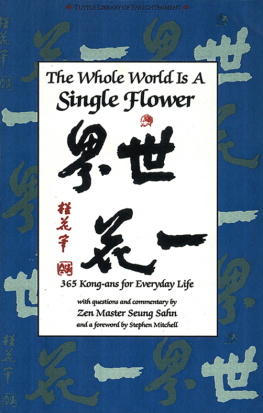
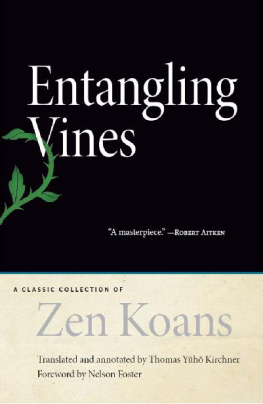
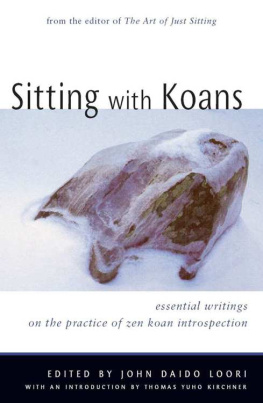
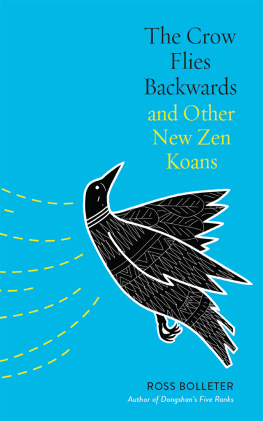
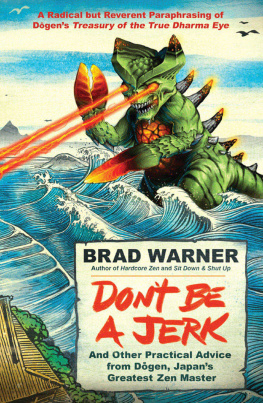

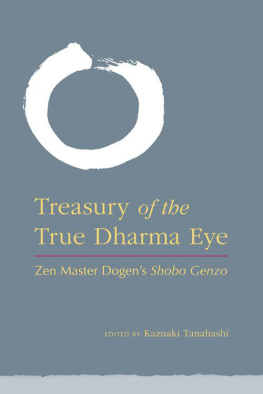
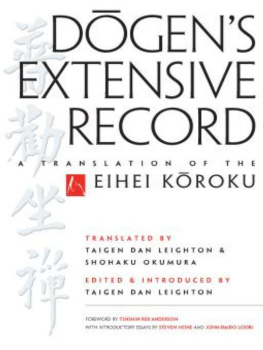
 Zen Master Dgens THREE HUNDRED KANS WITH COMMENTARY AND VERSE BY John Daido Loori TRANSLATED BY Kazuaki Tanahashi and John Daido Loori
Zen Master Dgens THREE HUNDRED KANS WITH COMMENTARY AND VERSE BY John Daido Loori TRANSLATED BY Kazuaki Tanahashi and John Daido Loori  Shambhala BOSTON & LONDON 2011 Shambhala Publications, Inc. Horticultural Hall 300 Massachusetts Avenue Boston, Massachusetts 02115 www.shambhala.com 2005 by John Daido Loori Cover art: Side View Daruma by Hakuin Ekaku (16851769). Used with permission of the Gitter-Yelen Collection. Cover design: Diana Coe/ko Design Studio All rights reserved. No part of this book may be reproduced in any form or by any means, electronic or mechanical, including photocopying, recording, or by any information storage and retrieval system, without permission in writing from the publisher. [Shb genz sanbyakusoku. [Shb genz sanbyakusoku.
Shambhala BOSTON & LONDON 2011 Shambhala Publications, Inc. Horticultural Hall 300 Massachusetts Avenue Boston, Massachusetts 02115 www.shambhala.com 2005 by John Daido Loori Cover art: Side View Daruma by Hakuin Ekaku (16851769). Used with permission of the Gitter-Yelen Collection. Cover design: Diana Coe/ko Design Studio All rights reserved. No part of this book may be reproduced in any form or by any means, electronic or mechanical, including photocopying, recording, or by any information storage and retrieval system, without permission in writing from the publisher. [Shb genz sanbyakusoku. [Shb genz sanbyakusoku.